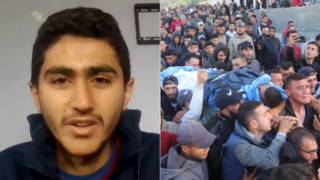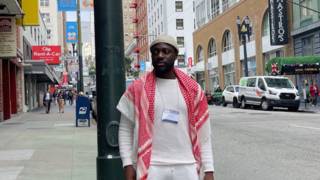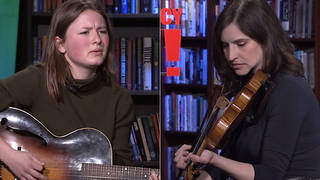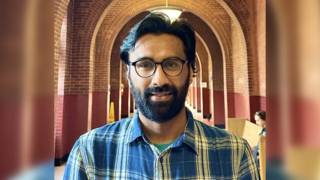
Topics
Guests
- Michael Reynoldscreator of radically sustainable living options through a process called “Earthship Biotecture.”
Links
New Mexico residents are trying to a break free from Los Alamos’ nuclear legacy by creating more environmentally sound ways of living. At the forefront of this struggle is renegade architect Michael Reynolds, creator of radically sustainable living options through a process called “Earthship Biotecture.” Reynolds’ solar homes are created from natural and recycled materials, including aluminum cans, plastic bottles and used tires. These off-the-grid homes minimize their reliance on public utilities and fossil fuels by harnessing their energy from the sun and wind turbines. In Taos, New Mexico, Reynolds gives us a tour of one of the sustainable-living homes he created. [includes rush transcript]
Transcript
AMY GOODMAN: We’re broadcasting from Los Alamos, New Mexico, the birthplace of the Nuclear Age. I’m Amy Goodman. The atomic bombs used in World War II were designed and developed here. Well, today, some residents of New Mexico are trying to atone for the history of war.
We turn right now to Mike Reynolds. At the forefront of those who are creating more sustainable ways of living is the visionary once-architect, Michael Reynolds. He’s creating radically sustainable living options through a process called “Earthship Biotecture.” The solar homes are created from natural and recycled materials, including aluminum cans, plastic bottles and used tires. These off-the-grid homes minimize their reliance on public utilities and fossil fuels by harnessing their energy from the sun, also from wind turbines.
We were driving along—from Durango, Colorado, to Taos, New Mexico, when we saw this remarkable collection, a fascinating collection, of structures scattered through the sage brush along the road. We pulled over and found Mike Reynolds consulting with a carpenter. He brought us into one of the first houses he built. He’s been documented in a documentary called Garbage Warrior. And he gave us a tour of one of the sustainable-living homes he created.
MICHAEL REYNOLDS: Greenhouse, which is a buffer zone for the house, to make the house stay warmer, hold its heat longer. The plants eat the sewage and provide food. And so, it just creates a whole different environment, a tropical environment, out of the super-cold desert, high desert environment.
AMY GOODMAN: So the house is a jungle?
MICHAEL REYNOLDS: Yeah, it’s pretty much, mostly, 50 percent, a jungle. We usually have bananas. We just harvested bananas here. This is tilapia. You can fish here. My eight-year-old grandson just did it on camera; he caught a fish here in like 30 seconds. And we grow them for protein. We have chickens out there. And so, the idea with this is to show that you can produce food, as enough to stay alive, in your own home.
AMY GOODMAN: And what is in—what is in these pillars of the house?
MICHAEL REYNOLDS: This is just holding up this little chamber up here that’s going to be a hot tub.
AMY GOODMAN: And what are these materials, though?
MICHAEL REYNOLDS: Those are just beer cans laid in cement, like bricks.
AMY GOODMAN: And bottles.
MICHAEL REYNOLDS: Beer cans and bottles laid in cement.
AMY GOODMAN: And why beer cans and bottles?
MICHAEL REYNOLDS: Because they’re natural bricks that every—they’re indigenous to the entire planet, and they’re all over the world. But this is the—see this? This stays this temperature year-round, no matter what.
AMY GOODMAN: This is a sort of a moist, warm, cool.
MICHAEL REYNOLDS: Yeah.
AMY GOODMAN: All at once.
MICHAEL REYNOLDS: In the wintertime, this feels warm; in the summertime, it feels cool.
AMY GOODMAN: And this is made with the back—
MICHAEL REYNOLDS: All the walls are made with—all these interior walls, except for—some of them are cans, but most of the walls are the tires pounded with earth.
AMY GOODMAN: And why tires?
MICHAEL REYNOLDS: Because tires are indigenous to the entire planet. When you beat dirt into them, they hold temperature and stabilize—stabilize the temperature, basically.
AMY GOODMAN: And so, all the back walls are made of these tires. And where do you get tires?
MICHAEL REYNOLDS: From the tire stores. They have to pay to take them to the dumps.
AMY GOODMAN: How many tires are there? Where do you—I mean—
MICHAEL REYNOLDS: Oh, there’s—we have a deal with the county. We have thousands of tires. Hello?
AMY GOODMAN: My goodness. We’re going into the bathroom right now.
MICHAEL REYNOLDS: Hello? OK, we’re going to go in and out of the [inaudible].
AMY GOODMAN: OK, we’re going into the bathroom. Can you describe this bathroom to us?
MICHAEL REYNOLDS: Well, the bathroom is just—it’s sort of in the jungle. It’s a sculpted bathtub. The toilet flushes into the septic system, which runs back into the planters. And the planters use it all. The sewage system is totally contained.
AMY GOODMAN: So why doesn’t it stink?
MICHAEL REYNOLDS: Well, it’s biology. Sewage doesn’t have to stink if you understand biology. Like, there’s a lot of things in nature that are really rancid, but nature takes care of it. And we’re just taking nature’s advice on how to deal with sewage rather than dumping raw sewage into a bay or an ocean.
AMY GOODMAN: Does this break rules?
MICHAEL REYNOLDS: Oh, yeah.
AMY GOODMAN: What are the rules it breaks?
MICHAEL REYNOLDS: Every one of them. It’s just—there are codes and rules. Now, we got variances, and we’ve got things in place. But the codes and rules are so stringent and so rigid that they are—they make it so we have to evolve very slowly as we try to break these—try to evolve these rules. And this—we’re on a planet now that is changing rapidly. And humans have to evolve rapidly to be able to stay alive on this planet. And the rules and the codes keep us from evolving rapidly. And I was pushing it too hard; that’s why they took my license. I’m trying to get us evolving faster. Yeah, I might make a mistake, and there might be a smell or something, but look at the mistakes they made with atomic energy. You know, that’s killing people and destroying continents. So—
AMY GOODMAN: You’re not far from Los Alamos.
MICHAEL REYNOLDS: I’m not far from Los Alamos, and I’m doing a hell of a lot less damage.
AMY GOODMAN: Tell us about the bedroom for a minute.
MICHAEL REYNOLDS: The bedroom is just—see, the bedroom is—look how many glass faces. One, two, three, when these doors close. Three glass faces away from the outside. And it’s wrapped with mass, so this bedroom just stays comfortable all the time, year-round.
AMY GOODMAN: So we have the bedroom. Then we have a set of glass doors. Then we have—
MICHAEL REYNOLDS: Set of glass doors.
AMY GOODMAN: —a forest.
MICHAEL REYNOLDS: And then another set of glass doors and one jungle, then another jungle and another set of glass doors. So half of it is—half of it is glass.
AMY GOODMAN: So, the quote that you have in the visitors’ center.
MICHAEL REYNOLDS: Well, they have a movie—they made a movie about this called Garbage Warrior. And it did good in film festivals. I didn’t make it. Somebody made it, and they spent four years following us around. And it was on—it was being screened in Toronto or Vancouver or someplace, and there was 900 people there. And they gave the movie a standing ovation, and then they started a Q&A. And they got into discussing everything and why we were doing it and everything. And I was just asked a question, and I just blurted it out. I didn’t really think. And what I blurted out was, “If all of the soldiers in all of the armies in all of the world were to put down their weapons and pick up tools and start making sustainable housing for all the people in the world, life would just begin on this planet.” And I didn’t really know what I’d said, but they wrote it down.
AMY GOODMAN: The material up here?
MICHAEL REYNOLDS: This is scrap metal and wood—and, you know, we use wood and cement and some—you know, the buildings are 45 percent recycled materials, I would say.
AMY GOODMAN: Tell me one more time about being near Los Alamos and what that means, the birthplace of the Nuclear Age.
MICHAEL REYNOLDS: Well, it’s—it really helped me get this law passed, because New Mexico was the state that destroyed 10,000 acres to test the atomic bomb. And Los Alamos is over there doing major, major damage for—for—I guess it’s for national security, is basically what it is. And I’m seeing that, from doing this—and I do this all over the world—that if everybody has everything they need, there won’t be anybody fighting over anything. Everybody will have everything they need. And this is a way to show people a path of how to get—it’s a lot of work. You have to got through a lot of work to get this. But it’s a pathway to everything that you need, not dependent on corporations, fossil fuels, governments, oil—anything. You can get everything you need in this house. Four people could live here and stay alive.
AMY GOODMAN: Were you as popular 10 years ago in the United States? You say you’re building this all over the world, but what about in the United States?
MICHAEL REYNOLDS: No, I went through long period of being a turd in a punch bowl, because it’s like—it was too many—you know, garbage is a—there’s a stigma around garbage. There’s a stigma around sewage. And we’re making them into a building and into your living room. And so, yeah, it wasn’t very popular at first, but it’s—now it’s like the world is changing so fast that people are starting to recognize anything is better than, say, a nuclear power plant in Japan that’s destroying a whole continent. Anything is better than the food that comes in the trucks, you know, that is grown for money, that is full of chemicals. The food that’s grown here, you can pick it and eat it. You can graze. You know, at lunch, I go into the different buildings and pick tomatoes or cucumbers, or our plant girl makes salads from the buildings. You can live. You won’t get fat, but you can live from these buildings without needing anything. And if you could imagine the billions of people on this planet living without needing anything, it would be a whole different planet.
AMY GOODMAN: So, Mike Reynolds, you lost your architecture license 10 years ago?
MICHAEL REYNOLDS: About that, yeah. It was—it was a controversy over breaking of rules, not following codes and regulations. I was kind of sensing a sense—you know, feeling a sense of urgency in trying to make sustainable housing happen faster. And I got—you know, I worked with the officials, but some of them died and retired and things like that, and all of a sudden new officials came in, and I was breaking every rule in the book.
AMY GOODMAN: So why didn’t you just stop?
MICHAEL REYNOLDS: Well, I didn’t—I didn’t want to stop. Turns out that I can go further faster without being an architect. As an architect, you can get fined for breaking rules and codes and regulations.
AMY GOODMAN: Like what codes are you breaking?
MICHAEL REYNOLDS: Well, like not doing sewage the way it’s supposed to be done in the regulation books, which is go into a septic tank and go out of the septic tank into the ground and contaminate the ground and the ground waters. That’s what’s supposed to be done. And sewage going into—every city in the world, pretty much, has got sewage going into rivers, streams, bays—a poor treatment of sewage. We are trying to contain the sewage on site and treat it. And that’s not allowed. That’s simply not allowed. You have to put it into the ground. And so—and then, furthermore, we’re taking part of it through the living room, you know, so that’s not allowed.
AMY GOODMAN: Why the living room?
MICHAEL REYNOLDS: Well, all the rooms, because it makes—it goes into botanical cells, which grow plants, and the plants give you oxygen in the rooms and food. And so, part of that—any part of the house is considered living. And if the sewage is being treated in the house, that was taboo.
AMY GOODMAN: Where do you get the water from?
MICHAEL REYNOLDS: We get the water from the sky—rain and snowfall—and we use it four times: we use the water for taking a shower; and then we use the water for running through the botanical cells growing plants; and then we collect it again at the end of the botanical cell and flush the toilet with that same water; and then that water gets treated in a septic or anaerobic system, and then it overflows into more botanical cells that are used for landscaping. So, in the end, no water ever leaves the premises that came from the sky.
AMY GOODMAN: If you’re not an architect, what are you?
MICHAEL REYNOLDS: Well, when they wouldn’t let me use the word “architect” anymore, I invented the word “biotecture” instead of architecture. And I use it all over the world now, because architecture is really not standing up to the demands of the day. And so, we wanted to create another profession that will address the demands of the day. Architecture is too wrapped up in itself to evolve. And it’s not—and consequently, it’s making buildings that—architects are making buildings that require $18,000 worth of fuel a month to keep them comfortable.
AMY GOODMAN: How much do people spend here on monthly utility bills?
MICHAEL REYNOLDS: If they pay over a hundred, we pay it for them.
AMY GOODMAN: Over a hundred what?
MICHAEL REYNOLDS: Per year, total annual utility bill, $100.
AMY GOODMAN: How do you get away with not paying utility bills?
MICHAEL REYNOLDS: There is no utilities. The electricity comes from the sun. The water comes from the sky. The sewage is treated on site. Everything is—by encountering the natural phenomena of the earth, you have everything you need, and you don’t need utilities. The utilities are bad, because they mine the earth for fuels and make nuclear power plants. But just as bad as that is the infrastructure that they use to deliver the utilities. And then they’re all run by corporations and so on. So, the people are vulnerable. This building, the people that live here are not vulnerable. They are a free people to exist no matter what happens to the economy or anything.
AMY GOODMAN: The houses go back into the earth, as if they’re coming out of the earth.
MICHAEL REYNOLDS: They—yeah, you’re embracing—the earth is embracing the buildings, pretty much like a mother holds a baby. The earth is holding the building, because the earth is a source of temperature. Just a few feet below the surface of the earth is a constant temperature. And we’re tapping into that temperature and then actually auxiliarating it with the sun.
AMY GOODMAN: And yet, you also are building tall row house-like earthships.
MICHAEL REYNOLDS: We’re doing that, because there is such a global interest in these, and one of the things they’re saying is that these are great for rural areas, but they wouldn’t work in an urban circumstance. So we’re trying to demonstrate that you can do two- and three-story row housing using these same concepts, and they’ll work every bit as [inaudible].
AMY GOODMAN: Mike Reynolds calls himself a biotect. You can go to earthship.com. This is Democracy Now!, democracynow.org, The War and Peace Report. We were speaking on the road into Taos.












Media Options